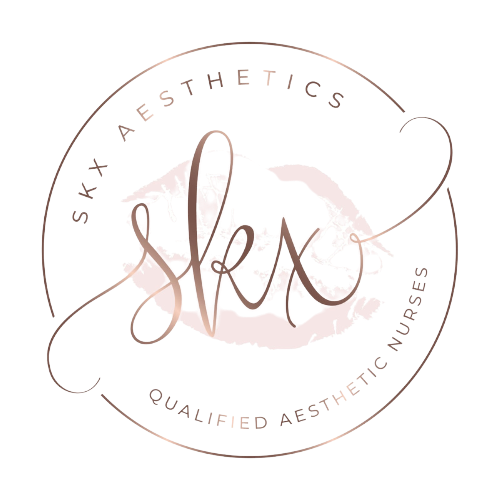Anti-wrinkle treatments
Lines, creases, or folds in the skin are called wrinkles. Dynamic wrinkles and static wrinkles are the two forms of facial skin wrinkles:
Dynamic wrinkles are lines, creases, or folds that develop on the face as a result of the recurrent pulling of the facial muscles. These include smile lines, crow's feet, frown lines, and forehead lines.
When an emotion is present, the face moves and reveals these wrinkles.
Lines, creases, or folds in the facial skin that are visible while the face is still and not moving are referred to as static wrinkles. Smoking, skin ageing, exposure to the sun, and long-term dynamic lines that become permanent can all contribute to static wrinkles.
Anti-wrinkle injections can be used to soften or prevent the onset of wrinkles, depending on the amount and the age being treated.
Additionally, anti-wrinkle products can be injected into the masseter muscle to treat excessive sweating in the hands, feet, or underarms as well as to thin the jawline.
What is Botox ?
Botox is an injection-based nonsurgical therapy. Botox serums come in a wide variety of brands and formulations, but they all contain an injectable component that is manufactured from a specific type of purified, human-friendly bacteria.
When injected, botox prevents the nerves from sending impulses to the body's muscles, making the muscles generally unable to contract.
Botox can be used successfully to soften and tighten other parts of the body, reduce the appearance of lines and wrinkles, and give other sections of the body a lift.
Each year, thousands of people undergo Botox injections; it can offer a natural-looking solution for the neck and face areas that cause the most complaints! The majority of cosmetic specialists are skilled in administering Botox, and the procedure is low-risk overall
1 Area | £100
Botox is frequently injected into three key areas: the vertical "11" frown lines between the brows, the crow's feet around the eyes, and forehead wrinkles.
Now you may be thinking “I’d like my crow’s feet and forehead lines treating – so that’s two areas, right?” Unfortunately, it isn't quite that easy. A trained professional would never fix the frown lines without also addressing the forehead. This is due to the fact that treating frown lines without treating the forehead could result in heaviness (brow ptosis).
2 Aeas | 145
In summary, you can anticipate two treatment locations if you'd like to reduce the horizontal lines across your forehead.
If you also want to reduce the appearance of crow's feet, this is considered one area if done alone or three places if done in conjunction with forehead and frown lines.
3 Areas| £180
Bunny Lines | £100
The tiny wrinkles that form on either side of your nose as you wrinkle it are referred to as "bunny lines." Bunny lines are brought on by repeatedly making particular facial expressions, just like many other types of face wrinkles.
Some individuals find these lines endearing, and they might be a normal part of ageing. Others could feel self-conscious because they think their face is ageing due to bunny lines. If you fit into the latter group, you might be thinking of getting bunny line Botox.
Gummy/Sad Smile | £100
A gummy smile occurs when the lip is raised over the gums when smiling. Typically, when someone smiles, we only expect to see the little, pinkish "triangles" (gingiva) between their teeth. While every sincere and real grin has the potential to be lovable, we work to give our patients the smile that they believe is the most attractive.
While a "gummy" smile may reveal 3 millimetres or more of upper gum tissues, a regular or "optimal" smile typically exposes no more than 2 millimetres. A "gummy" smile can make a person feel as though their teeth are smaller than they should be, reluctance to smile, or even self-consciousness. However, Botox therapy can enhance a "gummy" grin.
Teeth Grinding/Facial Slimming | From £200
To stop you from grinding your teeth, we provide botox injections in the masseter muscle close to the temporo mandibular joint (TMJ). Patients describe their alleviation as "liberating".
Small injections of the botulinum toxin (Botox) weaken the masseter muscle, which controls the jaw, sufficiently to halt clenching and teeth grinding out of habit.
It relieves TMJ pain, greatly relaxes the muscle, and lessens bruxism-related tooth wear and tear (the action of clenching or grinding).
Hyperhidrosis Treatment ( For Excessive Sweating) | From £250
There are many causes of excessive sweating, but the hereditary tendency is the most frequent one. In addition, secondary reasons may include diabetes, hyperthyroidism, or neurological conditions like Parkinson's disease.
Two basic categories can be used to classify hyperhidrosis:
Primary hyperhidrosis
30–50% of the population who are affected by primary hyperhidrosis have a hereditary predisposition to the condition. The cause is unknown for the vast majority of these people.
Secondary hyperhidrosis
Secondary hyperhidrosis may also result from a preexisting medical condition. The most prevalent conditions that result in excessive sweating are hyperthyroidism, obesity, abnormalities of the adrenal glands, and Parkinson's disease.
Hyperhidrosis is treated with Botox. The ideal way to treat secondary hyperhidrosis is to address the underlying issue, which should lessen excessive sweating. If this is not possible, like in the case of Parkinson's disease, Botox can be used to reduce excessive sweating.
Neck Bands | From £250
By injecting Botox into the platysma muscle, Botox is used to alleviate the wrinkles on the neck. To weaken this muscle, Botox is injected into it. This allows Botox to target the muscle that gives the appearance of bands, giving the neck a smoother and tighter appearance.
Meso Under Eye Treatment | £50
Under-eye injections with very tiny needles are used in mesotherapy for eye bags. The body uses the fat it extracts from the fat cells as fuel for metabolism when the injections' contents disperse into the fat cells.
As the bags are diminished, the decrease of fat under the eyes produces a considerably more youthful aspect.
Opening Times
Monday : 10am - 8pm
Tuesday : 10am - 8pm
Wednesday : 10am - 8pm
Thursday : 10am - 8pm
Friday : 10am - 8pm
Saturday : 10am - 8pm
Sunday : Closed
Contact Info
Address : 5, Richmond gardens,
Hardwick St,
Chesterfield
S41 7NS
Phone : 07401 107523
Email : info@skxaesthetics.com



